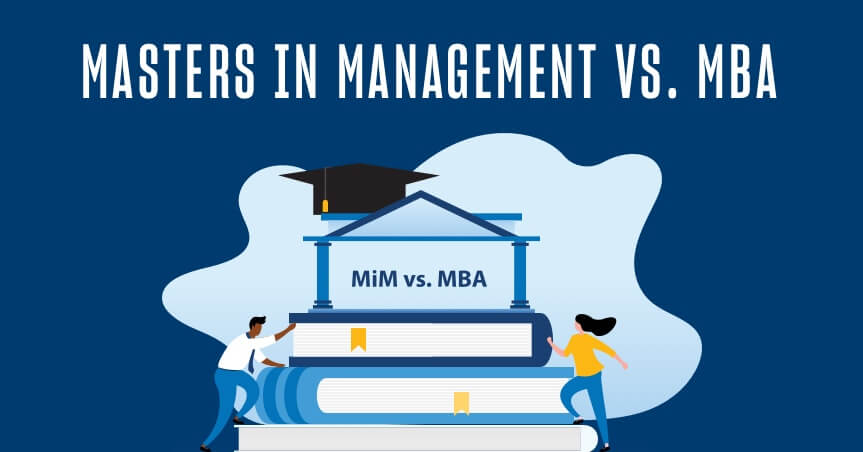Should you take a graduate admission exam if you’re thinking of attending an MBA program? And if so, which exam should you take?
For decades, Master’s of Business Administration (MBA) and related master’s programs have required applicants to take a graduate admission exam as part of the admissions process, with most schools specifically requiring the Graduate Management Admission Test (GMAT). However, many schools waived the exam requirement during the COVID-19 pandemic, and while some programs have reinstated the requirement, others — including many of the top U.S. business schools — continue to allow waivers.
In addition, over 1,300 business schools worldwide welcome the submission of Graduate Record Exam (GRE) scores as part of their admissions process. So, if you’re thinking about earning an MBA or other business degree, should you take either exam?
Read on as we review the difference between the GMAT and GRE, explore the advantages of one over the other and help you decide which exam is more worth your time and money.
GMAT vs. GRE (Overall)
The GMAT
Administered by the Graduate Management Admission Council (GMAC), the GMAT is widely used for admission to business schools and MBA programs. It is intended to measure the reasoning and critical thinking skills of applicants, with high scores demonstrating an ability to succeed in a rigorous graduate program.
The GMAT consists of four sections: Analytical writing, integrated reasoning, quantitative reasoning and verbal reasoning. The four sections will take place over 187 minutes and include the option of two 8-minute breaks for a total of just under three and half hours for the entire exam. Each section is scored differently, with the most important score being your composite score, which can range from 200 to 800.
The GMAT can be taken either at a test center or online, the differences being when appointments are available, which scratch work resources can be used and what are your test-taking accommodations.
For a fully detailed look at the GMAT — including a review of every section — see our companion blog post Every Question You Have About the GMAT, Answered.
The GRE
Administered by the Educational Testing Service (ETS), the GRE is widely used as an admissions consideration at thousands of graduate schools across all types of programs, from language and art to business and law. It is intended to evaluate the verbal and quantitative reasoning, critical thinking and analytical writing skills of applicants to determine if they can succeed in a graduate program environment.
The GRE is composed of three sections: Analytical writing, verbal reasoning and quantitative reasoning. The GRE’s two analytical questions take 30 minutes, the verbal section takes 60 minutes and the quantitative section takes 70 minutes, for a total of three hours and forty-five minutes for the entire exam. Unlike the GRE, there is no composite score; instead, it is the individual section scores that matter, with the verbal and quantitative scores ranging from 130 to 170 and the analytical writing ranging from 0 to 6.
The GRE can be taken either at a test center or online at home. The two exams are considered identical, with the only difference being how they’re administered.
GMAT vs. GRE Quick Comparison Chart
| GMAT | GRE | |
| Purpose | Required or suggested for admission to most business schools | Required or suggested for admission to most graduate schools |
| Cost | $250 online or $275 in person (includes free score delivery to up to five schools) | $205 (includes free score delivery to up to four schools) |
| Location | Online or at a testing center | Online or at a testing center |
| Format | Computer-adaptive exam | Computer adaptive by section exam |
| Sections | Four sections: Analytical Writing, Integrated Reasoning, Quantitative, Verbal | Three sections: Analytical Writing, Verbal Reasoning, Quantitative Reasoning |
| Length | 3 hours and 30 minutes, with the option of two 8-minute breaks | 3 hours and 45 minutes, plus one optional 10-minute break |
| Scores | The overall, or composite, GMAT score ranges from 200 to 800 in 10-point increments | Verbal and Quantitative scores from 130 to 170 in 1-point increments |
| Retesting | Five times within any continuous rolling 12-month period; each format (testing center or online) can only be taken once every 16 calendar days | Once every 21 days, but not more than five times in one calendar year |
GMAT vs. GRE (Quantitative Section)
Both the GMAT and GRE test for quantitative skills, though the GMAT is considered more rigorous and business focused while the GRE covers more question types, such as geometry.
Content Focus. The GMAT quantitative section covers math concepts with an emphasis on problem-solving and data analysis skills relevant to business and management contexts. In comparison, the GRE Quantitative Reasoning section covers a broader range of math concepts — from algebra and arithmetic to data analysis and geometry.
Question Types. The GMAT consists of just two types of questions: problem solving and data sufficiency. Problem solving assesses your ability to solve math problems using equations, graphs and data interpretation, while data sufficiency questions test your skills in determining whether given information is sufficient to answer a problem. The GRE Quantitative Reasoning section tests skills in algebra, arithmetic, data analysis and geometry, with the majority of the questions being multiple choice.
Scoring. The GMAT quantitative section is scored on a scale of 0-60, which contributes to the composite score ranging from 200-800. The GRE quantitative reasoning section is scored on a scale of 130-170. The score is reported separately and not combined into a composite score.
Length and Time. The GMAT quantitative section consists of 37 questions that must be answered within a time of 75 minutes. The GRE has two quantitative tests both consisting of 20 questions and a time length of 30 minutes.
GMAT vs. GRE Verbal Reasoning Quick Comparison
| GMAT | GRE | |
| Content Focus | Problem solving, data sufficiency | Arithmetic, algebra, data analysis, geometry |
| Number of Questions | 37 questions in 1 section | 20 questions each in 2 sections (40 total) |
| Time Length | 75 minutes | 30 minutes per section, 60 total minutes |
| Score Range | 0-60 | 130-170 |
GMAT vs. GRE (Verbal)
While the verbal reasoning sections of the GMAT and GRE both test for the same general skills, there are a few specific differences in which skills they focus on, how they’re scored and how long they’ll take.
Content Focus. The GMAT verbal section mainly tests for skills in grammar, reading comprehension and critical reasoning. The GRE verbal reasoning section has a greater emphasis on testing vocabulary, with questions meant to assess skills in analyzing written passages, understanding the meaning of words and sentences and drawing conclusions.
Question Types. The GMAT verbal section consists of three categories of questions: reading comprehension passages, critical reasoning questions and sentence correction. The GRE verbal reasoning section also has three categories, though its are: reading comprehension questions, text completion questions and sentence equivalence questions.
Scoring. The GMAT verbal section is scored on a scale of 0-60, which contributes to the composite score ranging from 200-800, while the GRE verbal reasoning section is scored on a scale of 130-170. The score is reported separately and not combined into a composite score.
Length and Time: The reading comprehension passages in the GMAT Verbal section are generally longer and more complex. There’s only one section with a total of 41 questions and a time length of 75 minutes. The GRE has two verbal sections, both consisting of 20 questions and a time length of 30 minutes per section.
GMAT vs. GRE Verbal Reasoning Quick Comparison
| GMAT | GRE | |
| Content Focus | Reading comprehension, critical reasoning, section correction | Reading comprehension, text completion, sentence equivalence |
| Number of Questions | 41 questions in 1 section | 20 questions each in 2 sections (40 total) |
| Time Length | 75 minutes | 30 minutes per section, 60 total minutes |
| Score Range | 0-60 | 130-170 |
GMAT vs. GRE (Integrated Reasoning)
The one major difference between the GMAT and the GRE is that the GMAT includes a section on integrated reasoning, whereas the GRE does not. You can think of this as a hybrid section, where you’ll be tested on your ability to conceptually interpret and synthesize information using both quantitative and verbal skills.
The integrated reasoning section consists of four problem types: multi-source reasoning, table analysis, graphics interpretation and two-part analysis. It is a 30 minute section consisting of 12 questions, with a score range from 1-8.
GMAT vs. GRE Verbal Reasoning Quick Comparison
| GMAT | GRE | |
| Content Focus | Multi-source reasoning, graphics interpretation, two-part analysis, table analysis | N/A |
| Number of Questions | 12 | N/A |
| Time Length | 30 minutes | N/A |
| Score Range | 1-8 | N/A |
GMAT vs. GRE (Analytical Writing)
Both the GMAT and the GRE have analytical writing sections, though the major difference is that the GMAT has only one essay prompt, while the GRE has two.
Content. The GMAT’s analytical writing assessment consists of one essay prompt where you will have to evaluate the strengths and weaknesses of a given argument, without expressing your own opinion. The GRE consists of two essay prompts: analyze an argument and analyze a task. The analyze an argument essay is similar to the GMAT essay, where you critique a provided argument. The analyze a task essay requires you to take a stance on an issue, justify your position with evidence and express your own opinion.
Scoring. All of the essays are graded on a 0-6 scale.
Time and Length. All of the essays are 30 minutes long, which means the GRE’s two-essay analytical writing section is twice as long for a total of 60 minutes. However, because the GRE lacks an integrative reasoning section, both exams have a similar overall testing time.
GMAT vs. GRE Analytical Writing Quick Comparison
| GMAT | GRE | |
| Content Focus | Analysis of an argument | Analysis of an argument, analysis of an issue |
| Number of Questions | 1 essay prompt | 2 essay prompts |
| Time Length | 30 minutes | 30 minutes per section, 60 total minutes |
| Score Range | 0-6 | 0-6 |
GMAT vs. GRE (Summary)
Your choice of the GRE or GMAT for an MBA program will largely depend on your school’s requirements, your prospective career, your timetable and even which areas you feel stronger in. If you’re still unsure of which test to take — consider how they differ:
They differ in focus. The GRE is accepted by a broader range of graduate programs, including business, arts, sciences and humanities. It includes two essay prompts instead of one and no integrated reasoning section. The GMAT, on the other hand, is specifically designed for admission to MBAs and related business and management programs. It has only one essay prompt and the section on integrated reasoning.
Their sections differ. While they both have quantitative and verbal sections, the content of these sections differ between theGRE and GMAT. The GRE puts a greater emphasis on testing vocabulary, understanding the meaning of words and sentences and drawing conclusions in its verbal section. The GRE’s quantitative section covers a wider range of mathematical concepts, such as geometry, but is considered less rigorous. The GMAT’s analytical section has a greater emphasis on problem solving and data sufficiency.
Their difficulties differ. The GRE is considered to have a more difficult Verbal Reasoning section, as the test places more emphasis on testing vocabulary, reading comprehension and analytical writing skills. The GMAT is considered to have a more difficult Quantitative Reasoning section, as it focuses more on quantitative reasoning and critical reasoning skills. If you’re unsure of which test might be harder for you, consider taking both the official GMAT practice exam and the official GRE practice test.
Their costs slightly differ. The GRE costs $205 and includes free score delivery to up to four schools. The GMAT costs $250 if taken online or $275 if taken in person and includes free score delivery to up to five schools.
Of course, if money isn’t a concern, one option is to take both tests and submit whichever has the higher score. If you decide to only focus on one exam, then select the test which best fits your strengths and aligns the most with your career goals.
If you are thinking of applying to business school, especially with an eye toward working in tech or developing a startup enterprise, then we invite you to consider the 100% online University of San Diego’s Master of Science in Innovation, Technology and Entrepreneurship (MITE) program. The MITE program is based around focused coaching on business, entrepreneurship and leadership within the computer and communications connectivity space.
In the MITE program, you’ll collaborate with fellow innovators and entrepreneurs while engaging with expert industry instructors from both the School of Engineering and the Knauss School of Business. It’s an in-depth experience in navigating the world of technology innovation, financing and product/market fit that doesn’t require the GMAT to apply.



